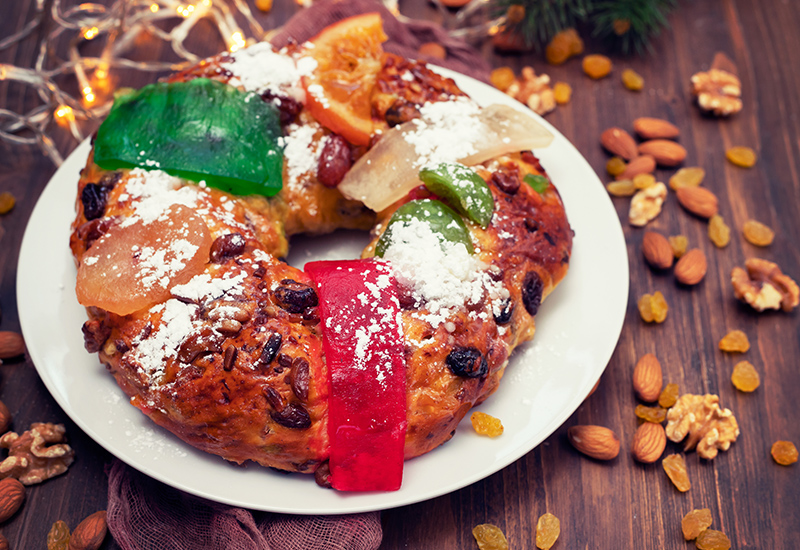Bolo rei – or king cake in English – is a staple of every Portuguese Christmas table. This sweet sticky bun-like cake has delighted young and old alike for almost two centuries, but you might be shocked to learn that it didn’t originate in Portugal at all.
To understand the origins of bolo rei, we have to go back to the Roman Empire, where the festivities of Saturnalia, which was a festival to honour the God Saturn, featured a pie with a dried bean placed inside it. Whoever found the bean would be crowned ‘king’ of the party. As Catholicism spread across Europe, this ancient tradition was incorporated into the modern-day Christmas festivities and Epiphany.
It was in 14th century France when the predecessor of bolo rei –galette des rois – was created based on the former Roman tradition and changed to resemble the Three Magi. One could quite easily mistake bolo rei or ‘rois’ for meaning king, as in Christ the king. In fact, it is related to the Three Kings, Saints Caspar, Melchior and Balthazar, who followed the star from the East to Bethlehem, where they found the baby Jesus lying in a manger and gave him gifts of gold, frankincense and myrrh.
The king cake eventually became popular in its current format during the reign of Louis XIV. It is alleged that the French painter Jean-Baptiste Greuze depicted the galette des rois in his famous painting Gâteau des rois. As the cake spread across France, it was partially banned in 1789 due to the French Revolution, but not wanting to lose out on trade, French bakers continued to make king cake under the name gâteau des sans-culottes, so as not to antagonise the authorities.

Galette des rois
Tradition states that galette des rois was to be eaten at the start of Epiphany, around 6 January. However, over time this sweet cake started to be consumed throughout the entire Christmas season. Similar in appearance to bolo rei, galette des rois is circular and originally included a crown-shaped base for the ‘king’ or queen who found the fava bean, which would have been baked inside the cake. Those who find the bean would then be responsible for buying or making the cake the following year. It is believed that in the past a small statue of the Christ child was baked in the cake but at some point this was replaced by the more edible fava bean. It has also been recorded that other ‘lucky’ charms have been used over the years, notably in the 1870s when small porcelain cat figures appeared in the cakes as well as porcelain beans which the finder would keep as a lucky token, so long as they hadn’t choked on it!
Over the centuries, as the king cake spread across Europe, it became an annual traditional sweet in countries such as Luxembourg and Belgium, and even as far away as Quebec in modern-day Canada. It wasn’t until the Portuguese monarchy’s official bakery, Confeitaria Nacional,opened in Lisbon in 1829 that bolo rei arrived in Portugal, becoming a staple of the Portuguese Christmas. It was introduced to the royal bakery in c.1869 by a French confectioner known as Gregório, who was recruited in Paris by Baltasar Rodrigues Castanheiro Júnior, who later adapted the recipe. No doubt, in the Royal household, bolo rei included a coin (likely a Portuguese real) in place of the more common fava bean. In contrast to the historic galette des rois, the bolo rei was jazzed up with crystallised and dried fruits and nuts whilst keeping the traditional round crown-like shape. As Brazil was then part of Portugal, bolo rei also made its way across the Atlantic, where it has also remained a part of Brazilian culture.
In days gone by as the family would gather around the table to celebrate the Feast of the Epiphany. The family’s youngest member would sit under the table and name each recipient who would receive a piece of cake to ensure a random distribution, with one piece set aside for a guest who may stop by unannounced.
Much like the temporary fate of the galette des rois, bolo rei was banned in Portugal for some time after the proclamation of the republic on 5 October 1910 because the name contained the word ‘rei’. Much like the French, some one hundred and twenty-one years earlier, Portuguese bakers decided to rename the cake bolo nacional or national cake. However, many behind closed doors continued to call it Christmas cake or ‘ex-bolo rei’. Those in authority were just as imaginative, calling it ‘republican cake’ or ‘president cake’ in line with the nationalist views of the time.
Eventually, bolo rei’s name was reinstated and celebrated in the religious way that it was intended; however, the modern introduction of health and safety led to the limit of any trinkets or dried beans being placed inside food products under the introduction of Decree-Law nº158/1999, of 11 May. While Article 4 prohibited ‘the marketing of foodstuffs containing mixed gifts’, Article 3 stated that bolo rei was exempt ‘for reasons of recognised cultural tradition’. However, this loophole was short-lived, as a review of this law several years later saw the ban on mixed gifts, including bolo rei.
Although now served minus the fava bean or any lucky trinkets, this nationally adopted cake has become the symbol of Portuguese Christmas and New Year, lining the shelves of our supermarkets and loved by many across the country and beyond.
In France, they continue to love their founding cake, so much so that according to a French survey in 2014, eighty-five per cent of French people celebrate Epiphany with king cake and nine per cent confessed to enjoying more than five helpings.
Little is known about the Three Kings to whom this historic cake is dedicated to but surprisingly, they are considered to be venerated in Germany. According to common belief, the Tomb of the Three Magi rests in Cologne Cathedral in Germany, having reputedly been discovered by Saint Helena on her pilgrimage to Palestine and the Holy Lands. It is said that upon their discovery, Saint Helena took the remains to the Church of Hagia Sophia in modern-day Istanbul before they were transferred to Milan and then to Cologne by the Holy Roman Emperor Frederick I in 1164.
Although bolo rei is a borrowed tradition to represent this sacred time in the Christian calendar, it reminds us of the gift of family, sharing and love, a true representation of what the Christmas season is all about.
As my story and this year come to an end, I wish you all a Merry Christmas and a prosperous New Year, and if you haven’t already, why not treat yourself to a bolo rei? I know I will.













